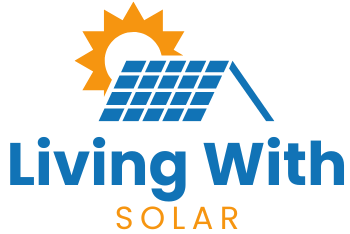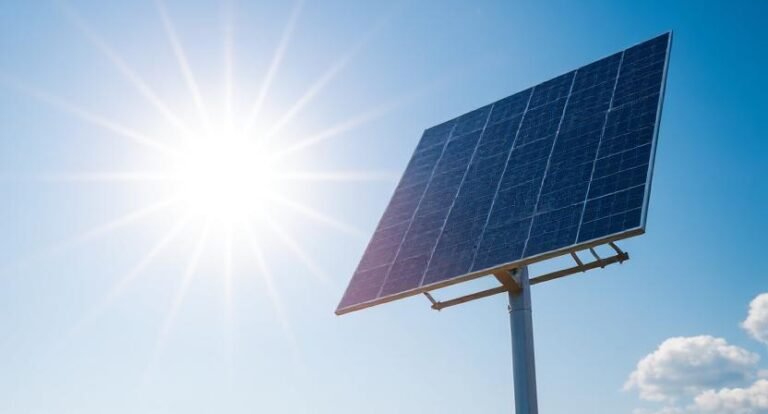At night, solar power relies on solar batteries to provide usable energy. During the day, solar panels generate electricity, which can be stored in these batteries for later use.
They convert excess energy into a form we can use when the sun sets. Lithium-ion batteries outperform lead-acid ones in efficiency and lifespan. If you’re curious about how these systems work and the benefits they offer, there’s a lot more to discover about solar battery technology and trends.
Power Your Home with Solar – See How →
Key Takeaways
- Solar batteries store excess electricity generated during the day for use at night, ensuring continuous power supply.
- They charge with DC electricity from solar panels and supply AC electricity through inverters for home use after sunset.
- Lithium-ion batteries are preferred for nighttime solar energy use due to their higher energy density and longer lifespan compared to lead-acid batteries.
- Proper system design and monitoring of Depth of Discharge enhance battery longevity and performance, optimizing nighttime energy availability.
- Solar batteries facilitate energy independence by providing power during outages and reducing reliance on the grid at night.
Understanding Solar Power Generation During the Day
Solar power generation is all about harnessing sunlight to create electricity, and it really shines during daylight hours. I find it fascinating how solar panels produce energy using photovoltaic cells, converting sunlight into electricity generation through the photovoltaic effect.
During peak sunlight, these panels work efficiently, and the electricity generated is primarily DC. Inverters change this to AC for home use. Any excess electricity can be stored in solar battery storage or fed back to the grid, allowing for net metering benefits. Understanding these processes helps me appreciate how I can optimize energy use and reduce my electricity costs.
The Function of Solar Batteries in Energy Storage
While many people think solar power is only useful during the day, the role of solar batteries is essential for maximizing energy usage at night. These batteries store excess electricity generated by solar panels, allowing me to tap into that energy when the sun goes down. I prefer lithium-ion batteries for their high energy density and longer lifespan.
They charge with direct current from the panels and convert it to alternating current through an inverter. In my grid-tied solar system, solar batteries provide backup power during outages and help me reduce reliance on the grid. Plus, they can qualify for tax credits!
How Solar Batteries Work With Solar Power Systems
Understanding how solar batteries integrate into my solar power system is key to maximizing energy efficiency. Solar batteries store excess energy as DC electricity generated during the day.
When the sun sets, this stored energy is converted to AC electricity through an inverter for home use. In AC-coupled systems, solar energy is first converted to AC before being stored as DC. Hybrid inverters streamline this process, managing both conversions efficiently.
This integration fosters energy independence, ensuring power availability during outages or low sunlight periods.
| Process | Description |
|---|---|
| Energy Storage | Storing excess DC electricity |
| Inversion | Converting DC to AC electricity |
| Hybrid Inverters | Managing both conversions |
| Energy Usage | Utilizing stored energy at night |
Benefits of Utilizing Solar Batteries at Night
By harnessing the power of solar batteries at night, I can enjoy the benefits of clean energy even when the sun isn’t shining. These batteries store excess energy generated during the day, allowing me to reduce my electricity bills by using stored energy instead of purchasing from the grid.
This shift not only boosts my solar energy usage but also enhances my energy independence, especially during outages.
Additionally, investing in solar battery systems can qualify me for valuable tax credits, making the financial advantages even more appealing. Ultimately, they help me minimize grid consumption during nighttime hours.
Comparing Battery Technologies: Lithium-Ion vs. Lead-Acid
When I think about battery options for solar power, lithium-ion and lead-acid come to mind. Lithium-ion batteries stand out for their impressive energy density and longer lifespan, which can save you money over time. On the other hand, lead-acid batteries might seem cheaper upfront, but their maintenance and replacement costs can add up quickly.
Energy Density Comparison
Although both lithium-ion and lead-acid batteries serve as essential components for solar energy storage, their energy densities highlight significant differences in efficiency and practicality.
Lithium-ion batteries typically offer 150-200 Wh/kg, while lead-acid batteries provide only 30-50 Wh/kg. This means lithium-ion systems are smaller and lighter, ideal for residential installations.
Additionally, lithium-ion batteries have a Depth of Discharge (DoD) of 80-90%, maximizing stored energy use, compared to lead-acid’s 50%. Here’s a quick comparison:
| Battery Type | Energy Density (Wh/kg) |
|---|---|
| Lithium-Ion | 150-200 |
| Lead-Acid | 30-50 |
Lifespan and Maintenance
While considering battery options for solar energy storage, it’s clear that lifespan and maintenance play crucial roles in the decision-making process. I find that lithium-ion batteries typically last 10 to 15 years, while lead-acid batteries only last 3 to 5 years.
The higher Depth of Discharge (DoD) of lithium-ion, at 80-90%, allows for more usable energy. Plus, lithium-ion requires minimal maintenance, whereas lead-acid needs regular checks. Here are some key points:
- Longer lifespan for lithium-ion
- Minimal maintenance for lithium-ion
- Higher energy density for lithium-ion
- Lower DoD for lead-acid
- More frequent replacements with lead-acid
Cost and Affordability
Choosing the right battery technology for solar power storage can greatly impact your overall investment. While lithium-ion batteries have a higher upfront cost, typically between $10,000 and $15,000, they offer better energy efficiency at around 95% and a lifespan of 10-15 years.
In contrast, lead-acid batteries are more budget-friendly initially, but their shorter lifespan and lower efficiency (80-85%) might not be as financially attractive long-term.
Tax incentives like the 30% federal solar tax credit can make lithium-ion systems a smart choice to store excess solar energy, helping you reduce your carbon footprint while maximizing your investment in energy storage technologies.
The Importance of Inverters in Solar Battery Systems
Inverters play an essential role in solar battery systems, as they transform the direct current (DC) generated by solar panels into alternating current (AC) that our homes can use.
These inverter systems guarantee efficient energy conversion and are vital for maintaining a continuous power supply, especially at night.
- Hybrid inverters streamline conversion from both solar panels and battery storage.
- They optimize energy usage with smart technology.
- Efficiency affects usable energy derived from stored solar energy.
- Inverters draw energy from batteries during low sunlight.
- They’re integral for maximizing the benefits of solar power systems.
Challenges of Solar Energy Storage Solutions
When I consider solar energy storage solutions, I can’t help but think about the challenges they present. The high upfront costs and limited storage capacity can really make homeowners hesitate, not to mention the concerns about battery lifespan.
It’s clear that while solar power is promising, there are significant hurdles to overcome for it to be a practical option.
Cost of Implementation
Implementing solar energy solutions, particularly with battery storage, can come with substantial costs that many homeowners find intimidating. The initial investment for solar battery systems typically ranges from $10,000 to $15,000.
Additionally, these systems have a lifespan of 5 to 15 years, meaning replacement costs can add up. Efficiency losses during charge and discharge can further reduce usable energy.
Thankfully, incentives like the solar tax credit can help offset implementation costs. To maximize energy savings, proper system design and professional installation are critical.
- Initial investment considerations
- Lifespan of battery systems
- Efficiency losses explained
- Solar tax credit benefits
- Importance of professional installation
Limited Storage Capacity
Even with the financial incentives available, I often find that many homeowners worry about the limitations of solar energy storage solutions.
Solar batteries usually have a limited capacity, ranging from 5 to 15 kWh, which may not suffice for larger households’ nighttime energy needs.
While lithium-ion batteries offer better energy density, they still struggle with total storage capacity. Charge and discharge losses can reduce usable stored energy by 10-20%.
Though advancements in technology are promising, the high costs and battery lifespan of 10-15 years remain challenges.
| Aspect | Details | Impact |
|---|---|---|
| Total Storage Capacity | 5-15 kWh | Limited nighttime energy |
| Charge/Discharge Losses | 10-20% | Reduced usable energy |
| Battery Lifespan | 10-15 years | Replacement needed |
Battery Lifespan Concerns
Although many homeowners are excited about the potential of solar energy, battery lifespan concerns often dampen their enthusiasm. Lithium-ion batteries, while better than lead-acid options, still face challenges like capacity degradation from frequent charging cycles.
Their lifespan typically ranges from 5 to 15 years, which can affect your overall investment since replacement costs can hit $10,000 to $15,000 for a complete solar battery system. To maximize battery lifespan, consider:
- Proper system design
- Monitoring Depth of Discharge
- Seeking professional assistance
- Understanding energy storage needs
- Planning for charging cycles
These factors enhance longevity and performance, ensuring a more effective solar solution.
Future Trends in Solar Battery Technology and Integration
As the demand for sustainable energy solutions grows, I’m excited to share that future trends in solar battery technology are poised to revolutionize how we harness and store solar power.
Solid-state batteries are emerging, offering higher energy density and improved safety. Integrating artificial intelligence in energy management systems will enhance energy storage efficiency, optimizing the performance of photovoltaic systems.
Additionally, ongoing research aims to reduce battery production costs considerably by 2025. The rise of recycling programs will promote a circular economy, minimizing waste and maximizing resource recovery, while improving grid flexibility during peak demand times. This is just the beginning!
Frequently Asked Questions
Should I Use My Solar Batteries at Night?
Absolutely, I recommend using my solar batteries at night. They provide a reliable energy source, reducing my reliance on the grid, lowering my bills, and promoting energy independence. It’s a smart choice for sustainable living!
How Do Solar Panels Work at Night Without Batteries?
I’ve learned that solar panels don’t produce electricity at night. Instead, I rely on the grid for power, using net metering to offset costs by sending excess energy I generated during the day back.
How Does Solar Power Still Work at Night?
Isn’t it funny? Solar power’s a daytime hero, but at night, it’s like a magician’s trick. I rely on stored energy from batteries or the grid, keeping my lights on when the sun’s snoozing.
How Long Do Solar Batteries Last at Night?
I often wonder how long solar batteries last at night. Typically, they can power my home for hours or even a day, depending on usage and battery size. So, it’s vital to monitor their efficiency regularly.





